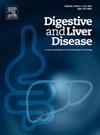肝移植前局部血管内治疗对移植后动脉并发症的影响
IF 3.8
3区 医学
Q1 GASTROENTEROLOGY & HEPATOLOGY
引用次数: 0
摘要
肝移植治疗肝癌占适应症的35%。由于器官供应有限,为了进入移植名单,肝细胞癌必须满足特定的标准。为了避免疾病进展,可以使用血管内治疗(LRT),如TACE和TARE。这些治疗也被用作降低分期。血管内治疗可能会损伤肝动脉,增加术后动脉并发症(狭窄、假性动脉瘤和血栓形成)的风险,需要再次移植的风险高达50%。本研究的目的是评估已经接受过LRT的肝移植患者与未接受移植前治疗的患者的血管和胆道并发症。方法回顾性观察性单中心研究纳入2010 - 2020年间所有肝细胞癌行肝移植的患者。结果在此期间,肝细胞癌行肝移植315例,其中181例(57.4%)行肝移植(LT-LRT), 134例(42.6%)未行肝移植(LT-noLRT)。两个种群具有同质性特征。动脉并发症发生率为1.9% (n=6),其中LT-LRT组n=3例(1.66%),LT-noLRT组n=3例(2.24%)(p值 = ns)。最常见的并发症是血栓形成(n=4)。胆道并发症发生率为9.84% (n=31),其中LT-noLRT组15例,LT-LRT组16例(p=ns)。最常见的并发症是狭窄(n=17),主要是内镜下治疗。晚期胆道并发症(6个月)发生率为12.7%,其中LT-noLRT组13例(10%),LT-LRT组16例(8.84%)(p=ns)。动脉和胆道并发症在动脉吻合术和LRT数量较多的患者中发生率更高。此外,治疗次数一般会影响并发症的发生,而不会影响动脉和胆道并发症。结论:在我们的研究中,肝移植前lrt不影响动脉和胆道并发症,尽管这些治疗会影响并发症的总数。动脉吻合口的数量和治疗方法可能是一个具有协同效应的危险因素。前瞻性和多中心研究可以帮助确定这些患者可能的危险因素。本文章由计算机程序翻译,如有差异,请以英文原文为准。
How the use of loco-regional endovascular treatment before Liver Transplantation impacts on post-transplant arterial complications
Introduction
Liver transplantation (LT) for hepatocellular carcinoma accounts for 35% of indications. Due to the limited availability of organs, to access the transplant list, hepatocellular carcinoma has to satisfy specific criteria. To avoid disease progression, endovascular treatments (LRT) such as TACE and TARE can be used. These treatments are also used as downstaging. Endovascular treatments may damage the hepatic artery, increasing the risk of arterial complications (stenosis, pseudoaneurysm, and thrombosis) in the postoperative period, with a need for re-transplantation up to 50%. The aim of this study is to evaluate vascular and biliary complications in patients undergoing LT who already received LRT compared to patients with no pre-transplant treatments.
Methodology
A retrospective observational single-center study was conducted on all patients who underwent LT for hepatocellular carcinoma between 2010 and 2020.
Results
During this period, 315 LTs were performed for hepatocellular carcinoma, of which 181 (57.4%) underwent LRT (LT-LRT) and 134 (42.6%) did not undergo LRT (LT-noLRT). The two populations had homogeneous characteristics. Arterial complications occurred in 1.9% of the total (n=6), of which n=3 in the LT-LRT group (1.66%) and n=3 in the LT-noLRT group (2.24%) (p value = ns). The most frequent complication was thrombosis (n=4). Biliary complications occurred in 9.84% (n=31), of which 15 in the LT-noLRT group and 16 in the LT-LRT group (p=ns). The most frequent complication was stenosis (n=17), mainly treated endoscopically. Late biliary complications (> 6 months) were also evaluated, which developed in 12.7%, of which 13 in the LT-noLRT group (10%) and 16 in the LT-LRT group (8.84%) (p=ns). Arterial and biliary complications occurred more frequently in patients with a greater number of arterial anastomoses and LRT. Additionally, the number of treatments affects the development of complications in general, without impacting arterial and biliary complications.
Conclusions
In our series, pre-LT LRTs do not affect arterial and biliary complications, although these treatments affect the total number of complications. The number of arterial anastomoses and treatments could be a risk factor with a possible synergistic effect. Prospective and multicentric studies could help to identify possible risk factor in these patients.
求助全文
通过发布文献求助,成功后即可免费获取论文全文。
去求助
来源期刊

Digestive and Liver Disease
医学-胃肠肝病学
CiteScore
6.10
自引率
2.20%
发文量
632
审稿时长
19 days
期刊介绍:
Digestive and Liver Disease is an international journal of Gastroenterology and Hepatology. It is the official journal of Italian Association for the Study of the Liver (AISF); Italian Association for the Study of the Pancreas (AISP); Italian Association for Digestive Endoscopy (SIED); Italian Association for Hospital Gastroenterologists and Digestive Endoscopists (AIGO); Italian Society of Gastroenterology (SIGE); Italian Society of Pediatric Gastroenterology and Hepatology (SIGENP) and Italian Group for the Study of Inflammatory Bowel Disease (IG-IBD).
Digestive and Liver Disease publishes papers on basic and clinical research in the field of gastroenterology and hepatology.
Contributions consist of:
Original Papers
Correspondence to the Editor
Editorials, Reviews and Special Articles
Progress Reports
Image of the Month
Congress Proceedings
Symposia and Mini-symposia.
 求助内容:
求助内容: 应助结果提醒方式:
应助结果提醒方式:


